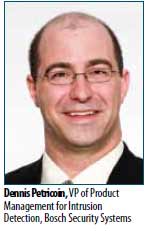SOFTWARE POWERS
PSIM and mapping software are coming into the spotlight with more offerings from established leaders and startups, especially for critical sites operating with multiple security systems. “The ability to integrate the many disparate security devices and locations within an organization into a common operating platform that enables efficient assessment and response from a command and control center as well as field personnel is highly desirable,” Curtiss said. For entry-level security management, alarm integration modules enable fast deployment interfaces to other security subsystems, using dry contacts for handshaking, Dewar said.
To facilitate integration between PIDS sensors and a security management system (SMS), it requires several things from the PIDS vendor. “First, a well thought-out software architecture — one that provides sensor management tools that can be used at the same time the PIDS software is exchanging information with the SMS, and one that allows the SMS to do a query for the current status of all sensors,” Dewar said. “By having this capability, after a power-up or restart, the SMS can quickly be synchronized to the state of the perimeter system. Second, a comprehensive SDK is required that clearly documents the protocol by which alarm and status information is exchanged and that provides a high-fidelity simulator so all sensor events can be simulated in software to test the eventual integration.”
The addition of video surveillance and VCA maximizes the effectiveness of a perimeter or intrusion detection system, which can both be managed through central management software. Video verification is carried out by PIR that triggers a camera and sends snapshots or a compressed video clip via the control panel to the monitoring station or directly to the end user for verification of the alarm, Joosens explained. “Both wired video verification systems as well as wireless video verifications systems exist, but as the distribution of the images is handled by the control panel, the systems are typically proprietary to the control panel manufacturer and interoperable with other intrusion systems. There are major differences in the various systems on the market in terms of the type of image sent, the image quality and the transmission time.”
“Video verification and analytics is a necessary combination that end users need to implement if they can. Let the PIDS detect the intruder and let the video provide the video surveillance to determine the appropriate response,” Smith said. Video surveillance solutions that interrogate and verify potential threats enhance the effectiveness and efficiency of perimeter security systems, Ionson said. “They enable timely and measured responses while dramatically reducing costly false alarms. Using 360-degree imaging, with its total situational awareness, to trigger a colocated PTZ camera to quickly zoom in on a suspicious event increases both the speed and accuracy of threat verification.”
WHAT'S NEXT?
Choosing the right perimeter security and intrusion detection products depends on the site that they are supposed to protect. There is no one solution for all perimeter security applications and each application should be approached with this knowledge, Dewar said.
“While specific challenges from site to site still exist, the introduction of standards across the board has led to significant advancements in the reliability of physical intrusion systems,” Makosinski said. 
When considering critical infrastructure, the requirements for intrusion detection are moving toward higher security, meaning better capture performance, better signal analysis and better communication solutions, with multiple paths and better integration into other subsystems, said Dennis Petricoin, VP of Product Management for Intrusion Detection, Bosch Security Systems. “We continue to see integration and flexibility as a key part of the industry's future.”
Selecting suitable products that satisfy end user requirements is only part of the equation. The second part of this feature explores key considerations system integrators should pay attention to during and after installing a perimeter and intrusion detection system.